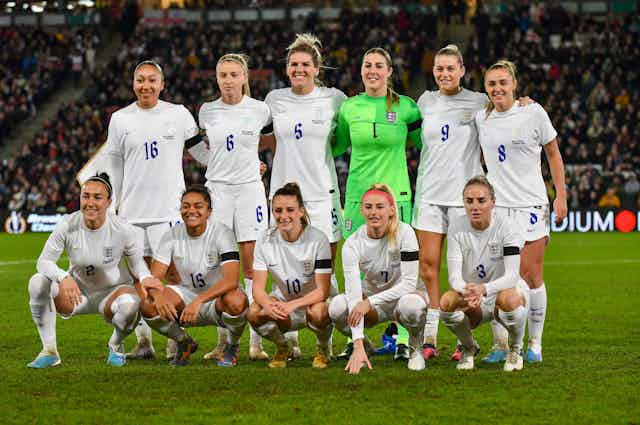The 2023 Fifa Women’s World Cup is probably the most highly-anticipated women’s football tournament ever. Part of this hype and enthusiasm might suggest that women’s football has finally “made it” and that catching up with the men’s game is just a matter of time. But there are ongoing issues that continue to jeopardise the women’s game.
Football is a huge part of society in many countries around the world – from the top levels of the professional leagues down to kids playing in the park – but the game is still primarily seen as a male endeavour. This influences how women’s football is organised, represented and equipped in ways that continue to restrict its success, safety and sustainability.
As the tournament rolls out, we want people watching and talking about it from an informed perspective. Here are five problems that women’s football is still struggling to overcome.
1. Players and teams are having to fight for fairness
Before the tournament began, key players from top teams such as France, Spain, Canada and Jamaica were protesting about poor support, resourcing and coaching by either refusing to play or openly criticising their federations and seeking advice from Fifpro, the international players union.
As we have seen in the first few days, this means that many of the key stories of the tournament so far have been about the drama that is happening off the pitch, rather than the dramatic performances on it.
2. Serious injuries are decimating squads
Many players will be missing during the World Cup due to a disproportionately high number of serious injuries that could have been prevented. Research needs to prioritise injury prevention in female athletes, as our current knowledge is largely based on men.
Female-specific equipment is also needed. The notorious anterior cruciate ligament (ACL) tear (in the knee) and other serious injuries decimating squads have, in part, been connected to overly long studs (cleats) on football boots which are designed for men.
Read more: Female football players are at much higher risk of career-ending ACL injuries – the science on why
Recent research has also found that 82% of female players reported pain and impaired performance from the available footwear. New “female” football boots are becoming available, but whether these are just female-branded or have substantive science-led changes in design remains unclear.
3. The European broadcasting deal came too late
The media broadcasting rights for five European nations, including England, were only agreed less than six weeks before the tournament began.
This fiasco arose from a blunder by Fifa, whose decision to decouple the men’s and women’s tournament broadcast rights was hyped to show the women’s game had “made it”. But it has proved premature and the low broadcast bids, which Fifa considered “unacceptable”, suggest the male dominated broadcast media remain unconvinced women’s football has much value in its own right.
The delays meant broadcasters had much less time to promote the event and build audience demand and attention than they usually would for major sport tournaments.
It also raises questions about the quality of broadcasts that will be available, which matters because it influences audience perceptions. Broadcast quality can either make women’s football look great or sub-standard – especially compared to the men’s coverage.
4. Many teams have been poorly supported and prepared
Many national federations have failed to provide adequate support, facilities and investment to adequately prepare teams. Coaching methods and management of some women’s teams have been heavily criticised, alongside cancellation of training camps and non-payment of players’ appearance fees.
The England team have made public their frustrations with the Football Association (FA) and its piecemeal negotiations, as they learned that unlike the US and Australian teams, they will not be receiving expected pay bonuses on top of Fifa prize money.
The FA also introduced new measures to restrict their participation in lucrative PR opportunities in the buildup to the tournament to ensure they were rested, only to change their minds when it was too late for players to take advantage. Given that international tournaments make up a large proportion of these players’ earnings, they need to know where they stand – and much further in advance.
5. Same old patronising marketing strategy
The marketing of the tournament has been underwhelming and over-reliant on conventional “inspiration” themes aimed at young girls – strategies that have little proven impact on participation and are often seen as patronising.
The global branding and promotion of the women’s game is typically fixated on two ideas. First, that only young girls are interested. Second, women footballers should be presented as role models for young girls.
This strategy is not accurate, as it obscures the existing adult audience for women’s football. Nor is it desirable or sustainable, as it doesn’t consider attracting wider audiences – men, boys, women without children – to the women’s game.

Showing support
These five problems indicate why progress in women’s football should not be taken for granted. Being aware of the issues can help us look past the hype and be mindful that the game is still in a precarious position.
But it is important that as we watch the Women’s World Cup we talk about it with our friends, post about it on social media and show big media corporations that there is a market for women’s football.
Join in the social pressure campaign to get proper support for the women’s game. Momentum gained from this summer’s tournament will only be maintained if we hold Fifa, governing bodies and the media to account to replicate the high standards that women have been producing on the pitch.

Looking for something good? Cut through the noise with a carefully curated selection of the latest releases, live events and exhibitions, straight to your inbox every fortnight, on Fridays. Sign up here.

